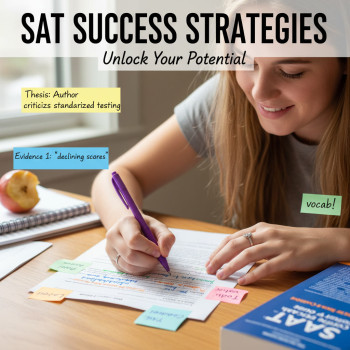AP vs SAT: A Friendly Compass for Undecided Explorers
If you re reading this, you ve already started the most important part of any journey: asking questions. Maybe you re a high school student juggling interests, or a parent trying to help a learner keep doors open. AP and the Digital SAT both carry weight in the college world, but they re different tools. This post is for students who want to explore not commit to a single path so you can make choices that stay flexible, strategic, and true to where you want to go.
Why Compare at All?
Because AP courses and the Digital SAT reward different strengths and open different doors. One emphasizes depth in a specific subject (AP), while the other measures broader academic skills and is often used as a common benchmark by admissions offices (Digital SAT). For undecided students, comparing them can reveal a practical way to maximize opportunities: take the classes that interest you, practice for the SAT when it makes sense, and use both to tell a fuller academic story.

Quick Snapshot: What Each Test Represents
Before we dig deeper, here s a snapshot to anchor the conversation.
| Feature | AP Exams | Digital SAT |
|---|---|---|
| Purpose | Earn college credit/placement and demonstrate college-level work in a subject. | Provide a standardized assessment of reading, writing, and math skills for college admissions and placement. |
| Timing | Course-length (typically a full academic year); exams administered in May. | Offered multiple times a year; digital format creates streamlined administration. |
| Format | Subject-specific exams; multiple choice plus free response in many subjects; some digital hybrid formats exist. | Adaptive digital test measuring evidence-based reading and writing plus math; shorter, on-screen interface. |
| What it shows colleges | Depth and initiative in a subject; ability to handle college-level coursework. | Academic readiness across core skills, comparable across applicants. |
One Short Moral
Think of AP as a way to say, I loved and completed advanced work in this subject, and the Digital SAT as a consistent tool colleges use to compare applicants from different schools and backgrounds. Both can be valuable; they just prove different things.
How to Decide When You re Not Sure
Undecided students have an advantage: flexibility. You can use this period to sample, learn what excites you, and still keep the pathway to competitive colleges wide open. Here s how to think about decisions at three different stages of high school.
Freshman and Sophomore Years: Explore and Experiment
- Take foundational courses first. Build strong algebra, English, and science skills those will help both AP classes and SAT prep later.
- Try an introductory AP course if you re curious (AP Human Geography or AP Psychology are popular entry points).
- Start low-stakes SAT practice. Short, consistent practice sessions help you learn the format and identify areas to strengthen without pressure.
Junior Year: Focus With Flexibility
This is often the heaviest year for both AP loads and SAT aspirations. If you re undecided, aim for balance.
- Take 1 3 AP courses in subjects you genuinely enjoy or in which you want to show mastery.
- Schedule your first Digital SAT attempt when you re comfortable many students test in spring or fall of junior year.
- Use AP exam timelines and SAT test dates to avoid conflict. Prioritize mental bandwidth; it s better to do fewer things well than many things poorly.
Senior Year: Use Evidence to Make Strategic Moves
By senior year you should have scores, grades, and clearer preferences. Use those data points to finalize plans.
- If AP scores are strong in a subject you might major in, emphasize that on applications and consider requesting college credit where it applies.
- If your SAT score needs a boost for scholarship or admission thresholds, a targeted retake can make sense especially if college deadlines allow it.
- Remember: colleges read the whole application. Strong grades, compelling essays, and meaningful activities matter as much as test scores.
How Colleges Use AP and the Digital SAT
Colleges use AP and SAT scores differently. It s helpful to map their roles so you can plan strategically.
AP Scores: Credit, Placement, and Academic Storytelling
AP scores (usually on a 1 5 scale) can earn you college credit or advanced placement how much depends on the college and the subject. More importantly, they re proof of rigorous coursework. For undecided students, a string of APs in different areas shows intellectual curiosity and the ability to tackle college-level material.
Digital SAT: Benchmarking Across Schools
The SAT provides a common yardstick that helps colleges compare applicants from different high schools and curricula. For students from small or lesser-known schools, a strong SAT score can confirm academic ability in a way that grades alone might not.
Practical Tip
If you love a subject, take the AP your passion will show in your performance. If you want to demonstrate broad academic readiness, plan a strong Digital SAT timeline but don t let it crowd out exploring APs that genuinely interest you.
Study Approaches: Different Training for Different Events
Preparing for AP tests and the Digital SAT is like training for two sports: both require stamina and skill, but the workouts differ.
AP Study Strategy
- Focus on depth: understand big concepts, practice long-form responses, and master subject-specific terminology.
- Use course materials: the AP Course and Exam Description (CED) is a roadmap to what colleges expect.
- Practice past free-response questions under timed conditions; learn the rubric and how graders award points.
- Group study can be helpful teach each other concepts to reinforce understanding.
Digital SAT Study Strategy
- Prioritize underlying skills: critical reading, data interpretation, grammar in context, and algebraic problem solving.
- Do timed practice tests on a device to get comfortable with the digital interface and adaptive nature of the test.
- Analyze mistakes carefully understanding why you missed a question is more valuable than repetitive drills alone.
- Use test-day routines to build stamina: practice full-length sessions with the same breaks and conditions as test day.
Where Personalized Tutoring Helps
Not everyone learns the same way. That s where personalized tutoring shines. A tutor can build a tailored study plan targeting weak areas, boosting strengths, and providing accountable practice. Sparkl s personalized tutoring, for example, blends 1-on-1 guidance, tailored study plans, expert tutors, and AI-driven insights to adapt pacing and focus. For undecided students, tutoring can help balance AP depth with SAT breadth so you don t burn out trying to do everything at once.
Cost, Time, and Stress: Practical Considerations
AP and SAT both cost time and money. Weigh these practical realities as you plan.
Time Investment
- AP courses generally run a full semester or year, with sustained workload and end-of-year exams.
- SAT prep can be concentrated (a few months of serious prep) or drawn out with periodic practice over several years.
Financial Costs
- AP exams have fees (schools often collect them in the fall), and some students may also pay for prep resources or tutoring.
- SAT registration fees, practice materials, and private tutoring costs vary many students offset costs with free practice tools and school resources.
Stress Management
Test anxiety is real. Students who juggle heavy AP loads and SAT prep can burn out. Prioritize sleep, mental health, and steady routines. Break study blocks into focused chunks (Pomodoro-style), and schedule low-pressure practice sessions to build confidence.
Real-World Scenarios: Choose a Plan That Fits You
Here are three scenarios with suggested approaches. Think of them as templates you can adapt.
Scenario 1 The Curious Explorer
You enjoy many subjects and aren t sure what to major in. Try this:
- Take one or two APs in areas you enjoy (history, psychology, or a science).
- Do moderate, steady SAT practice with the goal of taking the test once junior year.
- Consider light tutoring to stay organized and build foundational skills Sparkl s tutors can help create a balanced plan so you explore without losing momentum.
Scenario 2 The Theme Builder
You re leaning toward a potential major (e.g., engineering or literature) but not 100% sure.
- Take AP courses that align with that theme (AP Calculus or AP Literature).
- Plan SAT testing to coincide with your strongest academic season; use targeted prep to shore up any gaps that matter for scholarships or admissions.
- Use AP scores to signal commitment to a field while a solid SAT score shows broad readiness.
Scenario 3 The Strategic Minimalist
You want to minimize test stress but still keep options open.
- Take a few APs in subjects you are confident you can do well in without excessive stress.
- Focus on one strong SAT test date and one retake if needed.
- Lean on personalized tutoring for time-efficient review and practice that targets high-impact skills.
How to Read Scores and Use Them Effectively
Scores are tools use them to negotiate college credit, place into higher-level courses, or strengthen your application narrative.
AP Scores
AP scores are reported on a 1 5 scale. Many colleges give credit or placement for scores of 3 5 (policies differ by institution and department). Even when colleges don t grant credit, strong AP performance signals rigor on your transcript.
SAT Scores
Digital SAT scores are used for admissions and, in some cases, scholarship qualification. A balanced approach good SAT scores plus rigorous coursework and APs makes a strong academic profile.
Making a Flexible Plan: Checklist for Undecided Students
- Map your academic interests for the next two years and pick APs that match curiosity, not pressure.
- Schedule one SAT attempt in junior year; plan a retake only if it meaningfully improves your goals.
- Use school counselors to check college-specific AP credit policies for top-choice schools.
- Build a study calendar that alternates AP review blocks with SAT skill-building to avoid overload.
- Consider personalized tutoring for targeted boost 1-on-1 guidance and tailored study plans can speed progress, especially when juggling both AP and SAT prep.
Common Myths, Debunked
- You must take as many APs as possible. False. Quality beats quantity; colleges prefer deep engagement and strong grades.
- The SAT is everything. False. It s one piece of a larger application that includes GPA, coursework, essays, and activities.
- If you re undecided, don t take any APs. False. APs can help you discover passions and demonstrate readiness take them thoughtfully.
Final Thoughts: Keep Doors Open Without Overloading
For undecided students and their families, the best plan is a pragmatic one: explore with intention, measure outcomes, and adjust. AP courses let you dive deep into subjects and possibly earn college credit; the Digital SAT gives colleges a comparative snapshot of academic reasoning skills. Neither has to exclude the other. In fact, when used together smart AP choices plus a well-timed SAT you amplify your profile without locking yourself into a single identity.
If you want help creating a plan that fits your school schedule, interests, and stress tolerance, consider a tailored approach: a tutor who helps you balance AP depth with SAT breadth, builds a realistic study calendar, and gives feedback that matters. Sparkl s personalized tutoring model (1-on-1 guidance, tailored study plans, expert tutors, and AI-driven insights) is designed to adapt to students who are still exploring. It s about learning efficiently, not just harder.

Remember: whatever you choose now doesn t lock you into forever. Many students discover their academic path by trying things out, learning from scores and classes, and pivoting. Use APs to deepen curiosity, use the SAT to benchmark readiness, and use personalized support when you want a guide who meets you where you are. Keep exploring the journey is part of the destination.
Next Steps
- Talk to your school counselor about AP offerings and registration timelines.
- Pick a realistic SAT test date and schedule a practice test under timed conditions.
- Make a short list of APs you d enjoy; prioritize depth over a long roster.
- Consider a short consultation with a tutor to create a focused plan that balances AP work and SAT prep without burning out.
You don t need to have all the answers today. With curiosity, a clear plan, and sensible support, you ll be able to keep your options open and make confident choices along the way.
Good luck, and enjoy the exploration.















No Comments
Leave a comment Cancel